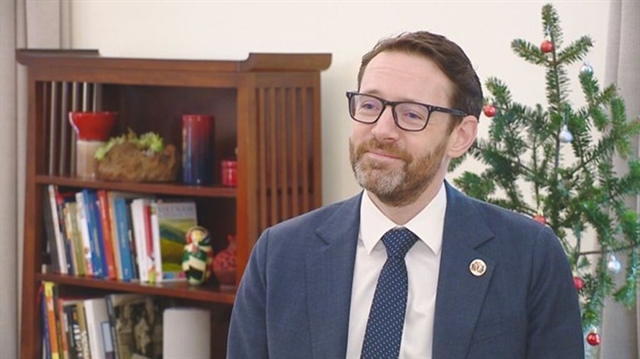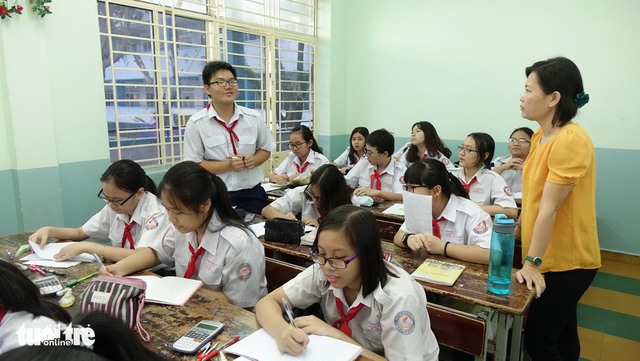

From next year, more art and music teachers will be needed in Việt Nam. This is because of a change in school courses.
 |
| A lesson at Collette Secondary School in HCM City’s District 3. - Photo tuoitre.vn |
From next year, more art and music teachers will be needed in Việt Nam.
This is because of a change in school courses.
There are more than two thousand eight hundred high schools in the country.
Five thousand six hundred new art and music teachers may be needed in them.
HÀ NỘI — There will be a shortage of some 5,400 arts teachers when the new general educational curriculum is first implemented in the 2020-21 school year, Tuổi Trẻ (Youth) newspaper reported.
According to the Ministry of Education and Training, the arts subject will combine music and fine art and will be taught at three levels with 70 sessions per year.
In the 2020-21 school year, the new curriculum will be applied at the primary school level. As it will be implemented gradually at higher levels, the ministry said schools still have time to recruit more teachers for new subjects.
At present, most high schools are in need of arts teachers.
There are about 2,800 high schools nationwide. If each school needs one music teacher and one fine art teacher, roughly 5,600 teachers need to be hired.
A similar situation is forming around computer science and technology at the primary school level. Previously, it was an optional subject offered based on a school’s condition.
With the new curriculum, more than 15,000 primary schools in Việt Nam have been asked to have their own computer science and technology teachers.
In the future, universities of pedagogy will have to offer courses to train teachers of integrated subjects.
According to the ministry, in the short term, it is prioritising improving the ability of current teachers to adapt to the new curriculum.
Schools have been encouraged to share their workforces and facilities, as well as have training courses on arts, technology and physical education for teachers.
The new curriculum aims to develop students’ competence through activities.
The first phase of basic education stretches from grade one to grade nine, while the second phase from grade 10 to grade 12 focuses on vocational training.
At the primary school level, students have to take lessons in Vietnamese, maths, a foreign language, lifestyle and ethics, nature and society, history and geography, science, computer science and technology, physical education and arts. Computer science and technology is a new subject at this level.
Secondary school students have to learn literature, maths, a foreign language, civic education, natural science, history and geography, technology, physical education, arts and computer science.
At the high school level, the compulsory subjects are literature, math, a foreign language, physical education and defence and security. Students will select optional subjects from social science, natural science, technology and arts.
The new curriculum is set to be implemented in the 2020-21 school year in primary schools, in 2021-22 at secondary schools and in 2022-23 at high schools. — VNS
GLOSSARY
There will be a shortage of some 5,400 arts teachers when the new general educational curriculum is first implemented in the 2020-21 school year, Tuổi Trẻ (Youth) newspaper reported.
A curriculum is a collection of subjects that make up a course that you study at a school or college.
If a curriculum is implemented it is put in place
According to the Ministry of Education and Training, the arts subject will combine music and fine art and will be taught at three levels with 70 sessions per year.
Combine means join together.
A similar situation is forming around computer science and technology at the primary school level. Previously, it was an optional subject offered based on a school’s condition.
If a subject is optional, you have the choice of taking it or not.
In the future, universities of pedagogy will have to offer courses to train teachers of integrated subjects.
Pedagogy is method and practice of teaching.
According to the ministry, in the short term, it is prioritising improving the ability of current teachers to adapt to the new curriculum.
If something is done in the short term, it is only for the near future.
Prioritising something means putting it at the top of the list of things to do.
To adapt means to fit in with something.
The new curriculum aims to develop students’ competence through activities.
Competence is a measure of whether someone is good enough for a certain task.
The first phase of basic education stretches from grade one to grade nine, while the second phase from grade 10 to grade 12 focuses on vocational training.
Vocational training is training towards doing a certain job.
At the primary school level, students have to take lessons in Vietnamese, maths, a foreign language, lifestyle and ethics, nature and society, history and geography, science, computer science and technology, physical education and arts. Computer science and technology is a new subject at this level.
Ethics are accepted and appropriate ways of behaving.
At the high school level, the compulsory subjects are literature, math, a foreign language, physical education and defence and security.
If something is compulsory, you have to do it. There is no choice.
WORKSHEET
Find words that mean the following in the Word Search:
y | h | c | h | i | r | t | s | r | y |
t | e | n | p | r | i | m | a | r | y |
b | l | a | i | m | e | a | a | h | f |
f | l | o | r | k | d | t | d | r | u |
j | k | e | c | t | k | h | i | d | t |
w | d | i | e | n | r | s | e | i | u |
s | e | c | o | n | d | a | r | y | r |
c | h | u | n | g | e | r | s | m | e |
1. Primary; 2. Secondary; 3. Maths; 4. Year; 5. Future.

.JPG)


